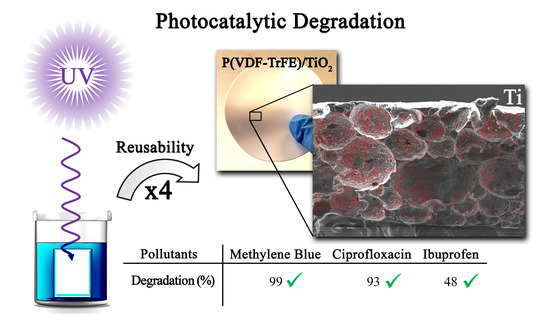Emerging pollutants are an essential class of recalcitrant contaminants that are not eliminated from water after conventional treatment. Here, a photocatalytic microporous membrane based on polyvinylidene difluoride-co-trifluoroethylene (PVDF-TrFE) with immobilised TiO2 nanoparticles, prepared by solvent casting, was tested against representative emerging pollutants. The structure and composition of these polymeric membranes were characterized by scanning electron microscopy, energy dispersive X-ray spectroscopy, Fourier-transform infrared spectroscopy, porosimetry, and contact angle goniometry. The nanocomposites exhibited a porous structure with a uniform distribution of TiO2 nanoparticles. The addition of TiO2 did not change the structure of the polymeric matrix; however, it increased the wettability of the nanocomposite. The nanocomposites degraded 99% of methylene blue (MB), 95% of ciprofloxacin (CIP), and 48% of ibuprofen (IBP). The microporous nanocomposite exhibited no photocatalytic efficiency loss after four use cycles, corresponding to 20 h of UV irradiation. The reusability of this system confirms the promising nature of polymer nanocomposites as the basis for cost-effective and scalable treatments of emerging pollutants.

Emerging pollutants are an essential class of recalcitrant contaminants that are not eliminated from water after conventional treatment. Here, a photocatalytic microporous membrane based on polyvinylidene difluoride-co-trifluoroethylene (PVDF-TrFE) with immobilised TiO2 nanoparticles, prepared by solvent casting, was tested against representative emerging pollutants. The structure and composition of these polymeric membranes were characterized by scanning electron microscopy, energy dispersive X-ray spectroscopy, Fourier-transform infrared spectroscopy, porosimetry, and contact angle goniometry. The nanocomposites exhibited a porous structure with a uniform distribution of TiO2 nanoparticles. The addition of TiO2 did not change the structure of the polymeric matrix; however, it increased the wettability of the nanocomposite. The nanocomposites degraded 99% of methylene blue (MB), 95% of ciprofloxacin (CIP), and 48% of ibuprofen (IBP). The microporous nanocomposite exhibited no photocatalytic efficiency loss after four use cycles, corresponding to 20 h of UV irradiation. The reusability of this system confirms the promising nature of polymer nanocomposites as the basis for cost-effective and scalable treatments of emerging pollutants.
